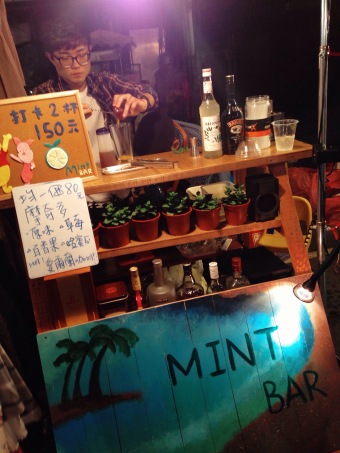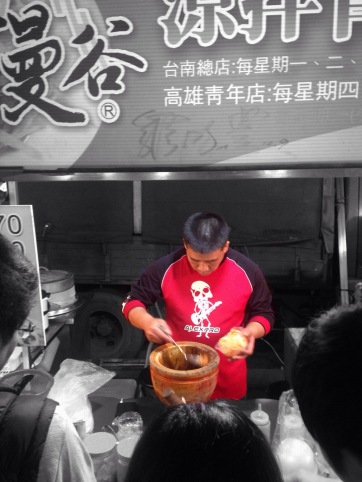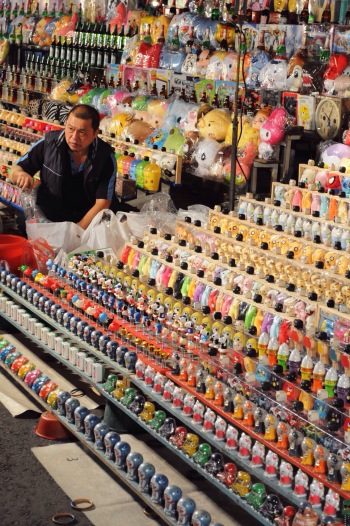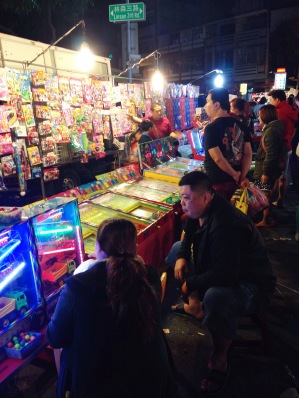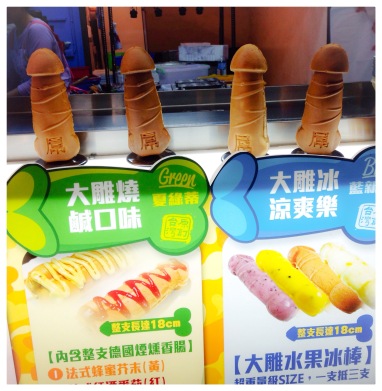Taiwan is often ignored by the dominant forces in travel publishing. It rarely makes the cut on any of the “Top Ten Tropical Getaways” lists that litter the interwebs, and the under abundance of drug induced beach parties largely keep it off the backpacker circuit, but the few glitzy websites that do give Isla Formosa some play almost never forget to include Taiwan’s night markets as must see attractions, and rightly so.
Similar to strip malls in suburban America (only less tacky) and Trattorias in Italy (only more crowded), you’re never too far from a night market in Taiwan. Ask any Taiwanese where their favorite night market is and they’ll probably give you two; mention your favorite night market and they’ll respond with one that’s better. The open air conglomerations of food stalls, clothing shops, carnival games and craft stands are best taken in with all senses–ideal places to smash on local food, try your hand at mahjong bingo, people-watch to your heart’s content and browse for everything from panty hose to house pets.
For expats in Taiwan it’s sometimes easy to ignore the lure of night markets and it might take an argument over just which one is the best before you rediscover why making weekly visits to your neighborhood night market is a part of life for those who call Taiwan home. Fail to check out a few night markets as a visitor and you’ll indeed be missing out on an interesting chunk of Taiwanese culture.
Somewhat driven by a recent visit to the Labor Park Night Market ( 老公夜市) near my apartment in Kaohsiung, I snapped a few photos of night market scenes worth sharing and dug through my iPhone for old ones as well.
Probably the most highlighted aspect of Taiwan’s night markets is the food. The general rule when dining out in night markets ought to be to keep an eye out for stalls that have their food reviews on display or have a line of patrons. These tend to be long-standing tenants with reputations for serving up culinary crack. Of course this doesn’t mean you should pass up stalls without queues and newspaper clippings, but with so much grub competing for your attention, it’s nice to have some local guidance.
Eating your way through a night market will also mean coming across some pretty weird shit. Chicken feet, pig blood cake and duck tongues are mainstays and I promise you’ll smell the stinky tofu long before you actually see it. Be as adventurous as you want, but I stop short of animal rectums (no chicken ass, please) and most insects (shoutout to Andrew Zimmern).
When I ask my students what they enjoy most about night markets the majority of them mention the games: toss a ring, shoot a bottle, pop a balloon; it’s all there–plenty to choose from if you’re looking for a place to win a stuffed Hello Kitty for your girlfriend or to park the kids for a couple of hours while you try on sunglasses and fish for live shrimp. I often chuckle when seeing kids go buck wild at a game stall while mom and dad sit nearby scrolling through Facebook, passing money to the game operator every few minutes to keep the party going.
Even more interesting, there’s usually a gaming section devoted to mahjong bingo where for NT$15-$20 a game, you can flip over fifteen mahjong tiles with the hope of landing a straight line on the gaming board. You’d think gambling was involved considering how many people hunker down in front of the tiles, but prizes rarely exceed the normal collection of children’s toys and stuffed animals.
I’ve noticed that while there are common threads that run through almost all night markets, each one still has its own unique vibe. Some are massive and cater to tourists looking to snatch up a few Chinese made souvenirs and pose for photos while holding stinky tofu. Others are more chill and locally driven–narrow lanes where people stop to grab their favorite dumplings or grilled squid on their way home from school or work. Some night markets function better as social hubs: landmarks to meet at with friends and browse but never buy; places where broke teenagers can take their dates.
Some of my favorite night markets are mainly clothing markets selling T-shirts with incorrect English printed on them and wide arrays of clubbing garb, priced to sell and in line with the latest fashion from Korea, Japan and the U.S. Two years ago on my birthday I bought a cap at the New Shinkuchan Night Market in Kaohsiung loaded with so much bling that I felt like a Saudi prince as soon as it touched my skull. There’s no way you’d find that type of swag in SOGO or any other department store chain in Taiwan.
Still, there are some night markets that are unapologetic in their randomness, completely undefinable and seemingly unmatched in their versatility. Meccas of commerce that have no problem catering to those who’d like to pick up a new cell phone case, have a pair of jeans tailored, get a manicure and snack on strawberry glazed penis cakes all at the same place.
Find Dreadlock Travels on Instagram: @jaywoodson
Author’s note: If you’re in Kaohsiung, Taiwanvore has done a fine job mapping out a lot of the night markets in the city. Peep his Photo walk through the Labor Park Night Market post as well.


